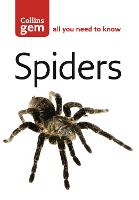


|
|
| book details |
Spiders (Collins Gem)
By (author) Paul Hillyard, Photographs by Premaphotos Wildlife

|
| on special |
normal price: R 120.95
Price: R 108.95
|
| book description |
A handy, pocket-sized guide to 220 of the world’s spiders, Gem Spiders is the perfect introduction to these ‘creepy-crawlies’ There are approximately 35,000 known species of spider in the world, but it is estimated that the true number in existence could be nearer 70,000. They occur everwhere naturally and, because of their sharp bite and venom, they are one of the most successful groups of animal. Each entry includes: A photograph of the spider and details of any distinguishing features which may help identification Information on size, web, habitat, distribution range and the times of the year when it is most likely to be spotted An icon shows the potency of each spider’s venom Each species is sorted by family and illustrated with a symbol, enabling you to quickly find what you are looking for. There is a detailed introduction which covers aspects of spiders’ natural history, their relatives, anatomy, the production and uses of silk. From the Goliath Tarantula to the patu digua, this photographic guide is the perfect introduction for those who want to learn about these fascinating creatures.
| product details |

Normally shipped |
Publisher | HarperCollins Publishers
Published date | 2 Aug 2004
Language |
Format | Paperback / softback
Pages | 256
Dimensions | 117 x 82 x 16mm (L x W x H)
Weight | 160g
ISBN | 978-0-0071-9171-0
Readership Age |
BISAC | nature / butterflies & moths
| other options |

Normally shipped |
Readership Age |
Normal Price | R 247.95
Price | R 223.95
| on special |
|
|
|
To view the items in your trolley please sign in.
| sign in |
|
|
|
| specials |
|
|
|
Let's stare the future down and, instead of fearing AI, become solutionists.
|
This first comprehensive biography of Cecil Rhodes in a generation illuminates Rhodes’s vision for the expansion of imperialism in southern Africa, connecting politics and industry to internal development, and examines how this fueled a lasting, white-dominated colonial society.
|
|
|
|